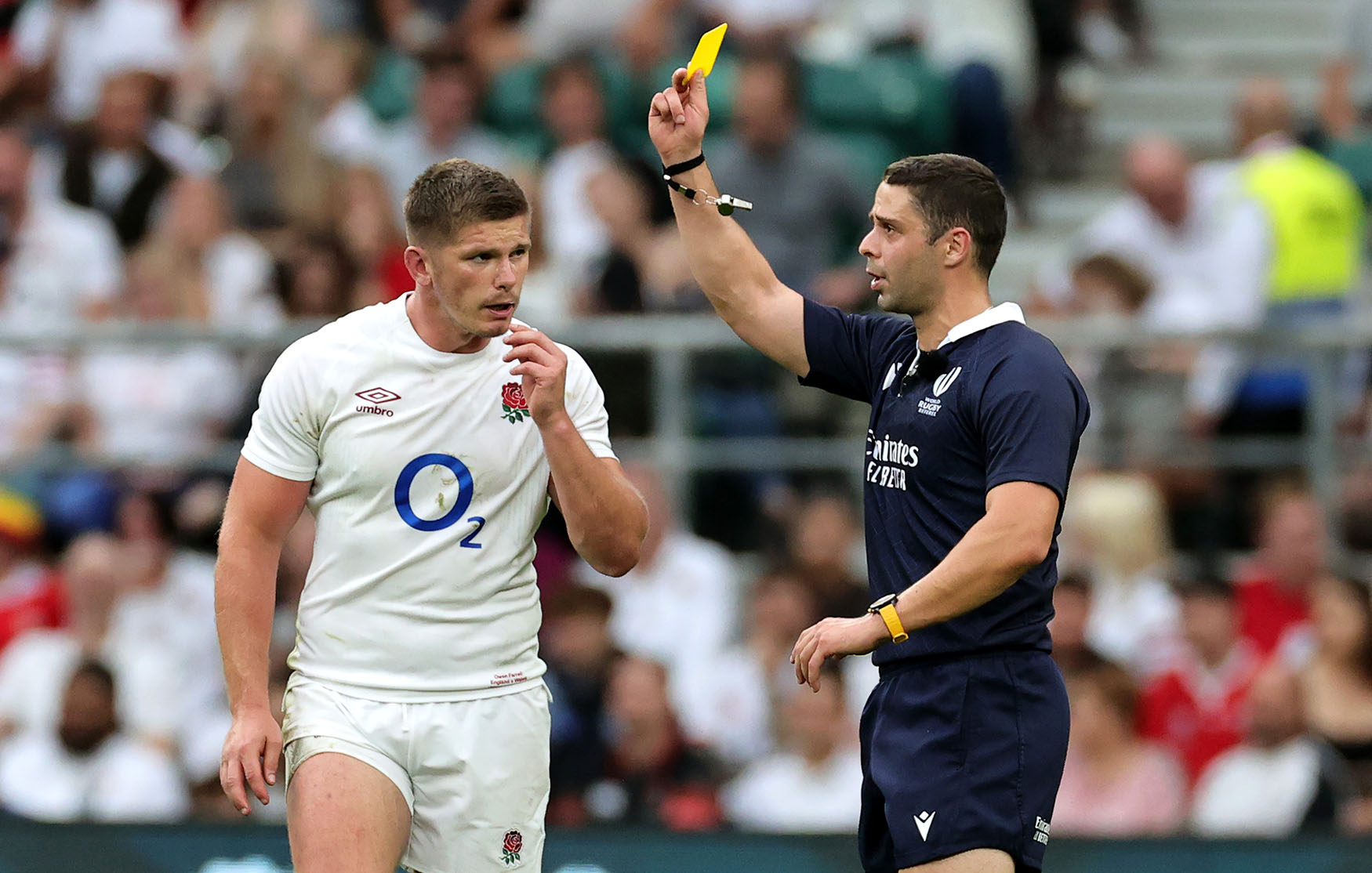Despite the Owen Farrell farce during a less-than-auspicious trial, the Television Match Official (TMO) “bunker review system” will be in place at the Rugby World Cup in France in a bid to avoid controversial red cards potentially ruining matches in the sport’s shop window.
The system means that if a referee considers an offence not to be a “clear and obvious” sending off, he can show a yellow card and, while the player is serving his 10 minutes in the sin-bin, a TMO reviews the offence and has the option of upgrading the yellow to a red.
The thinking behind the system is twofold. First, World Rugby wants to avoid a repeat of contentious decisions where players have been sent off for marginal offences that, on review via many TV angles, have appeared to be not worthy of the ultimate sanction.
Second, they want to save time, so instead of a referee standing on the pitch going back and forth through his microphone asking for myriad replays, those discussions take place in the “bunker” as the game continues.
 Owen Farrell of England leaves the field after receiving a yellow card, which is later escalated to a red, during a match against Wales at Twickenham on 12 August 2023. (Photo: David Rogers / Getty Images)
Owen Farrell of England leaves the field after receiving a yellow card, which is later escalated to a red, during a match against Wales at Twickenham on 12 August 2023. (Photo: David Rogers / Getty Images)
The concept, also trialled in other competitions around the world this year, has been broadly welcomed by players, coaches and fans, but the Farrell debacle last month showed that it is still an issue subject to opinion and error.
Read more in Daily Maverick: Rugby World Cup 2023
Farrell was sin-binned for shoulder-to-head contact with Wales’s Taine Basham and, as expected, his yellow was upgraded to red as he sat on the touchline.
When he went for his independent disciplinary hearing there was widespread incredulity when the panel found that, rather than earning a long ban, the England captain should not have been sent off at all, because of a late change of direction by Basham.
World Rugby appealed and another independent committee ruled that the previous one had been wrong, and that Farrell should serve a four-match ban, ruling him out of the first two games at the World Cup.
Divided opinion
Supporters of the bunker system claim the incident was a good example of how it should work, and that the initial overrule was something that could have happened had Farrell been shown a straight red.
Opponents suggest it removes too much authority from referees who will now almost never show a straight red knowing they have the “comfort blanket” of the bunker.
One of the high-profile incidents that persuaded the governing body to act was the red card shown to England full-back Freddie Steward in this year’s Six Nations. He collided with Ireland’s Hugo Keenan but the card was subsequently rescinded – too late, of course, to help England, who lost the match.
Read more in Daily Maverick: The Walking Wounded – down before the first RWC 2023 whistle blows
Unsurprisingly, Steward welcomed the change. “I think it’s a good step forward,” he told the Daily Mail. “Games are significantly affected and when it’s 15 v 14 it’s a different game, so if the right decision is made or the wrong decision is made it gives an opportunity to correct that.
“And when a decision like that takes about five or 10 minutes out of the game, it’s not good for the spectators, and it’s not good for the players to have that break.”
The need for the system is the result of the sport’s general clampdown on “dangerous contact”, whether that is a high or reckless tackle/ruck entry or taking out an opponent in the air, even if a player is making a legitimate attempt to challenge for the ball.
In contrast to most sporting foul play laws, a player in the latter situation is penalised on “outcome” rather than intent, and many have found themselves sent off even after trying to pull out of an aerial challenge if their opponent still ends up landing awkwardly.
The 2019 World Cup featured several high-profile red cards for high tackles and while the clampdown was relatively new then, players have had four more years to work on their technique and should have no excuse should they find themselves punished for going anywhere remotely near an opponent’s head.
England are without Farrell and Billy Vunipola for their first two matches after bans for dangerous tackles, but scrumhalf Danny Care said the team were working on tackle technique every day, under the guiding eyes of a guest referee.
“In big games, you need 15 players on the pitch,” he said. “There will be some reds in the World Cup and we are just hoping they are not ours.” Reuters/DM




 Owen Farrell of England reacts as they leave the field after receiving a yellow card, which is later escalated to a red following a TMO Review, during the Summer International match between England and Wales at Twickenham Stadium on August 12, 2023 in London, England. (Photo by David Rogers/Getty Images)
Owen Farrell of England reacts as they leave the field after receiving a yellow card, which is later escalated to a red following a TMO Review, during the Summer International match between England and Wales at Twickenham Stadium on August 12, 2023 in London, England. (Photo by David Rogers/Getty Images)